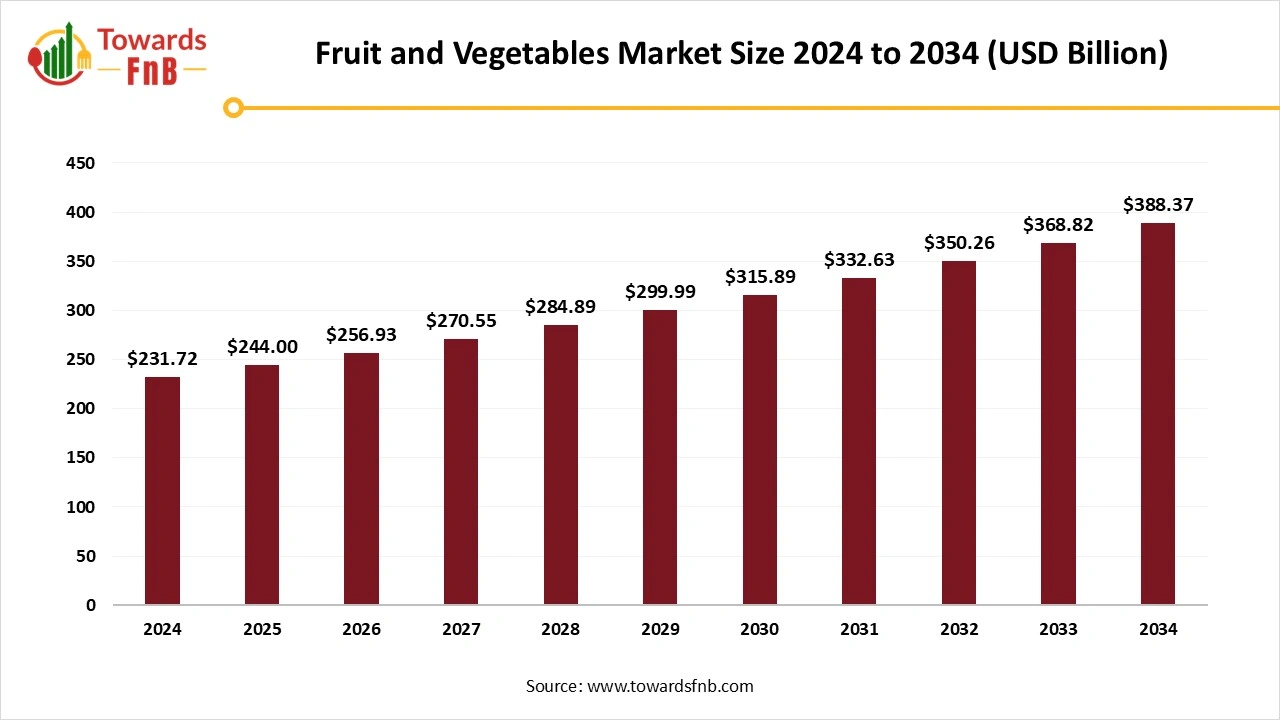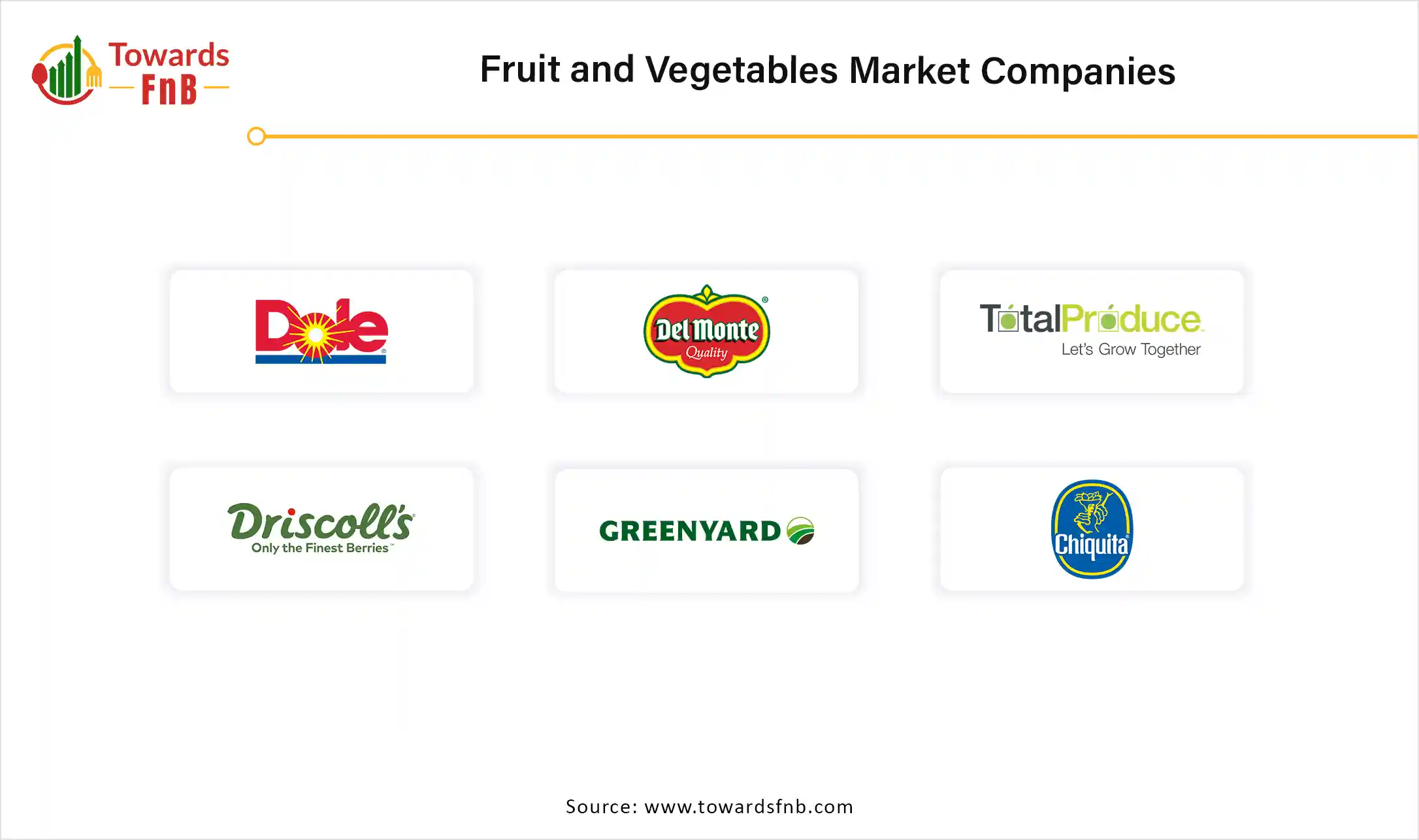January 2026
The global fruit and vegetables market size reached at USD 231.72 billion in 2024 and is anticipated to increase from USD 244 billion in 2025 to an estimated USD 388.37 billion by 2034, witnessing a CAGR of 5.3% during the forecast period from 2025 to 2034. The expanding agricultural production and favorable imports and exports are suitable for the growth of fruits and vegetables globally.

| Study Coverage | Details |
| Growth Rate from 2025 to 2034 | CAGR of 5.3% |
| Market Size in 2025 | USD 244 Billion |
| Market Size in 2026 | USD 256.93 Billion |
| Market Size by 2034 | USD 388.37 Billion |
| Largest Market | Asia Pacific |
| Base Year | 2024 |
| Forecast Period | 2025 to 2034 |
| Regions Covered | North America, Europe, Asia-Pacific, Latin America, and Middle East & Africa |
The fruit and vegetables market encompasses the cultivation, harvesting, processing, packaging, distribution, and sale of edible plant-based produce, including fruits and vegetables. It covers a wide range of product forms fresh, frozen, canned, dried, and processed across both conventional and organic farming models.
This market plays a central role in global food systems, supporting both human nutrition and agro-economy, and includes both domestic/local produce and international trade flows.
The top exporters from several countries and regions contribute to the expansion of global produce. These major exporters of fruit to the U.S. include Mexico, Peru, Costa Rica, Guatemala, and Chile. Moreover, the major exporters of vegetables to the U.S. include Mexico, Canada, Peru, China, and Guatemala. The major importers also help to ensure the availability of these food products year-around in the respective countries.
The producers face different challenges due to the rapid evolution of customer demands and preferences. There can be an unexpected impact of climate change on agricultural output. The extreme weather conditions can reduce the production of both fruits and vegetables.
How Asia Pacific Dominated the Fruit and Vegetables Market in 2024?
Asia Pacific dominated the fruit and vegetables market with a market share of 37% in 2024. The food industry uses some fruits and frozen berries to produce jellies, jams, bakery goods, preserves, desserts, and ice-cream. Beverage makers in the beverage industries use fruits like frozen berries to produce smoothies, fruit juices, and flavored alcoholic drinks. According to research studies, about 25.6% of the Asian Pacific population is employed in agriculture, fishing sectors, and forestry, which makes this sector crucial for economic stability and food security. The Asia Pacific region has adopted nature-based solutions to boost employment opportunities in this region. These nature-based solutions are used for agriculture, food systems, and climate resilience.

What are the Indian Provisions for Food Processing Expansion?
In March 2024, the Ministry of Agriculture, Food, and Rural Affairs of Korea announced its major policy plans for 2024. In March 2025, the Ministry of Information and Broadcasting introduced new policy decisions and budgetary provisions to transform the agricultural and dairy sectors in India. The Ministry of Food Processing Industries announced the launch of the ‘Operation Greens Scheme’ to promote agri-logistics, professional management, and processing facilities. The Indian Ministry is implementing this scheme to develop onions, tomatoes, and potatoes.
How the Investments and Partnerships for Food Security Expand the Middle East and Africa?
The Middle East and Africa are expected to grow at the fastest CAGR in the fruit and vegetables market during the forecast period. The Saudi Public Investment Fund works with the private sector and collaborated with U.S. agriculture company AeroFarms. This collaboration was intended to establish and maintain indoor vertical farms across the North Africa and Middle East. The Ministry of Climate Change and the Environment in the UAE introduced the Food and Agriculture Entrepreneurs Programme to help farmers and agri-businesses to receive training in sustainable agricultural management.
How Green Initiatives of Saudi Arabia Foster its Rapid Growth?
Saudi Arabia took more than 85 initiatives to reach up to the green targets under the Saudi Green Initiative for a long-term transformation. These efforts are made to protect the biodiversity, reduce GHG emissions, and create new protected areas. The Saudi Green Initiative aims to enhance the energy efficiency program of Saudi Arabia by 2030 and achieve waste management transformation in Riyadh by 2035. It also aims to use captured carbon to produce synthetic fuel and chemicals by 2027, transform its domestic energy mix by 2030, and achieve clean hydrogen production by 2030.
How Fruits Segment Dominated the Fruit and Vegetables Market in 2024?
The fruits segment dominated the market with a market share of 54% in 2024 owing to the great source of essential vitamins and high fiber content in fruits. Fruits are excellent sources of vitamins, phytonutrients, and minerals. Fruits like apricot, apple, and grapefruit reduce the risk of cardiovascular diseases due to the presence of flavonoids, potassium, fiber, carotenoids, and magnesium.
The vegetable segment is seen to grow rapidly as a sub-segment in the fruit and vegetables market during the forecast period. Due to the potential health benefits of eating vegetables that improve digestive health, help in weight loss, and reduce the risk of kidney stones. Vegetables improve blood pressure, eyes, reduce the risk of cancer, and boost the immune system.
What made Fresh Produce the Dominant Segment in the Fruit and Vegetables Market in 2024?
The fresh produce segment dominated the market in 2024 owing to the impact of fresh produce in managing cancer, blood sugar, hypertension, fiber, nutrients, and digestive health. The fresh produce supports consumers with enhanced energy levels, improved skin health, and improved brain health.
The juices and purees segment is expected to grow at the fastest CAGR in the fruit and vegetables market during the predicted timeframe. Due to the health benefits of juices, which are rich in nutrients and antioxidants. The juices and purées aid in weight management, detoxification and hydration. They are natural energy boosters which offer enhanced mental clarity, promote skin health, and support a healthy immune system.
How did the Conventional Farming Segment Dominate the Fruit and Vegetables Market in 2024?
The conventional farming segment dominated the market in 2024 owing to the advantages of conventional agriculture, which include high productivity, economic efficiency, better pest and disease management, etc. It offers large-scale food availability and advanced mechanization.
The organic farming segment is expected to grow at the fastest CAGR in the fruit and vegetables market during the forecast period. Due to the sustainable approaches and agricultural practices of organic farming that protect soil and ecosystems. It aims to reduce water pollution and prevent the loss of biodiversity.
How Supermarkets/Hypermarkets Segment Dominated the Fruit and Vegetables Market in 2024?
The supermarkets/hypermarkets segment dominated the market in 2024 owing to the easy access and presence just near residencies. The pleasant ambience and strategic design contribute to enhanced customer satisfaction and customer attraction.
The online retail/e-commerce segment is expected to grow at the fastest CAGR in the fruit and vegetables market during the predicted timeframe. Due to the benefits of online or e-commerce platforms in terms of multiple features in one tool and enhanced customer reach. These platforms offer easy access to digital marketing channels, the utilization of social media for engagement, and e-mail marketing campaigns.
What made Household/Direct Consumption the Dominant Segment in the Fruit and Vegetables Market in 2024?
The household/direct consumption segment dominated the market in 2024 owing to structural reforms and efficient resources. It boosts public spending on rural social welfare and economic growth in terms of investment, employment, and fiscal policy. It offers social benefits, including improved living standards, social welfare, consumer information, and financial planning.
The institutional buyers (schools, hospitals) segment is expected to grow at the fastest CAGR in the fruit and vegetables market during the forecast period. Due to their major role in professional management, substantial capital base, and many other benefits. They receive and offer access to various analytical tools which allow them to increase returns, reduce losses, and transform their investments.
Fresh Del Monte Produce
Foodiverse and Taylor Farms

By Product Category
By Processing Type
By Cultivation Method
By Distribution Channel
By End-Use
By Region
January 2026
December 2025
December 2025
December 2025